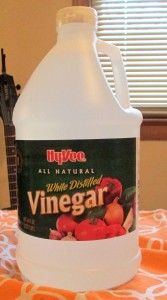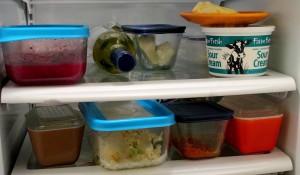You may catch more flies with honey, but when it comes to cleaning- vinegar’s the stuff!
There are shelves upon shelves of chemical cleaners in most stores. And a lot of these products perform exactly as advertised. You can also easily find a large selection of green cleaners. And again, these do the advertised job and aren’t that much more expensive than the competing toxic products.
 But when is the last time you’ve gone down the food aisle to pick up something to clean your home?
But when is the last time you’ve gone down the food aisle to pick up something to clean your home?
Vinegar is a standard go-to in our house. When the coffee pot starts running slow, we run 7 cups of vinegar to 3 parts water through the machine’s brew cycle. We then steep 2 pots of water only, to neutralize any remaining vinegar taste or smell. The vinegar solution thoroughly cleans our coffee machine.
Do you have lingering stains in a tub, sink, or toilet? Cover about 1/4 of the dirty surface volume with vinegar and let it sit for a few hours and then scrub clean (add a coating of baking soda first, if you really need to get at the grit). If your pipes are running slow, sprinkle in about a ½ cup of baking soda, followed by 1 cup of vinegar. Let that bubble and sit for about 15 minutes. Follow up with a blast of hot water and your pipe is not only disinfected, but should be running a lot better.
You can clean your windows and mirrors with a vinegar solution. Add 2 cups water to about 1/4 cup vinegar in a basic spray bottle. If you notice streaking, add a teaspoon of dish soap to the mixture. Those streaks aren’t the fault of the vinegar, but appear due its interaction with a prior cleaning agent.
It is true that vinegar has a very distinct smell. But we find it pleasant and it dissipates quickly. Honestly, the smell of vinegar is a lot more welcome in our home than those fierce chemical scents. Especially in tight and hard to vent spaces, like bathrooms.
What are some of your green cleaning tricks?
